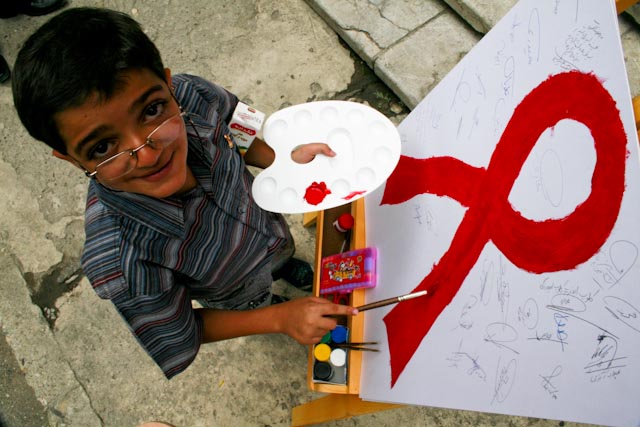Enhancement of National HIV Response with Focus on Target Beneficiary Groups in line with the fourth National Strategic Plan (NSP) 2015-2019
Background
Iran has a concentrated HIV epidemic with a low prevalence of less than 0.1% in the general population and about 13.8% among People Who Inject Drugs (PWIDs).
The partnership with the Global Fund started with an HIV grant in 2005 to strengthen surveillance and monitoring, disseminate information about HIV, reduce HIV risk and vulnerability, and improve access to quality care and treatment. This was followed by three subsequent Global Fund grants approved in 2010 (Round 8), 2015 (New Funding Model1) and 2018 (New Funding Model2). The New Funding Model project (NFM1) concluded in 31st March 2018 and the NFM2 project started from 1st April 2018 to 31st March 2021 as a continuation fund.
Like NFM1, the NFM2 project is also aligned with priorities of the 4th NSP with the goal of limiting prevalence rates among key populations and scaling up HIV prevention, care and treatment services for People who Inject Drugs (PWID), High-risk Behaviour Women Affected by HIV, Prisoners, People Living with HIV (PLHIV) and Pregnant Women living with HIV in different settings of the project including Voluntary Counselling and Testing Centres(VCTs), Drop-In-Centres, Out-reach Teams, Mobile Clinics, Positive Clubs and etc.
The project has also supported the national counterpart to improve Resilient and Sustainable System for Health.
Under the 4th HIV/AIDS NSP 2015-2019, the new grant is being implemented by several national and international parties through the programme management, coordination and convening services of UNDP as the Principal Recipient of the grant. The project aims to work towards achieving the following goals by the end of 2019:
- By end of 2019, at least 90% of PWIDs used sterile injecting equipment the last time they injected.
- By the end of 2019, at least 60% of the PWIDs have done HIV testing through PIT approach.
- By the end of 2019, at least 50% of the High-risk Behavior Women Affected by HIV have done HIV testing through PIT approach.
- By end of 2019, 90% of estimated PLHIV will be identified and know their status.
- By end of 2019, 90% of identified cases will be put on ARV treatment.
- By end of 2019, 80% of people on ARV will be virally supressed.
Key achievements to date:
The following achievements have been made as results of NFM1 and NFM2 projects:
- Contributed to national planning capacities for HIV control through the 2nd, 3rd, and 4th NSPs by conducting surveys, developing protocols/guidelines, etc. The project is now contributing to the development of the 5th NSP.
- To support the Government of Iran towards fulfilling the gap in the first 90, the GF NFM2 project continues its contribution to the process of shifting from facility-based approach to mobile-based approach through being pioneer in conducting initiatives to increase the access of hard-to-reach population to HIV services. The establishment of four mobile clinics, procurement of eight mobile vans and nine conexes has been among initiatives started by the GF NFM1 project and is being continued during the NFM2 to enhance the capacity of national system towards reaching out to the first 90.
- Conducted harm reduction programs and testing in prisons through applying Provider- Initiated Testing approach (PIT) and expanded harm reduction services for people who inject drugs and High-risk Behaviour Women Affected by HIV through different fixed and mobile facilities.
- Towards achieving the second 90, first HIV/AIDS Drug Resistance Laboratory in Iran as the only facility in its kind in MENA region to monitor ART system and increase the adherence to treatment among PLHIV was established.
- The project continues to procure ARV medicines and required health and non-health items to improve the coverage and quality of care and treatment services for PLHIV which is towards achieving the second and third 90s.
- To support the national partners to develop the capacity of their staff in the national, provincial and field level to increase their knowledge and skills on HIV prevention, care and treatment services, especially with new approaches and updated data quality mechanisms and tools.
Future funding requirement:
Building on the achievements of the previous projects, the current project aims to contribute to the national efforts for the implementation of the 4th NSP on HIV/AIDS and support development of the 5th NSP. It is in alignment with the new global strategy of checking the epidemic by 2030 with a set of highly ambitious targets called the “90-90-90 Targets” aiming to achieve the following objectives by 2020:
- 90% of all people living with HIV will know their HIV status;
- 90% of all people with diagnosed HIV infection will receive sustained antiretroviral therapy; and
- 90% of all people receiving antiretroviral therapy will have viral suppression.
For Iran to reach the milestones is a challenging task in technical, institutional and financial terms. The country needs support from the international community to be able to effectively contribute to this global agenda.

 Locations
Locations


